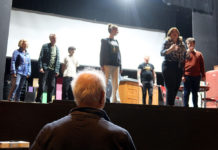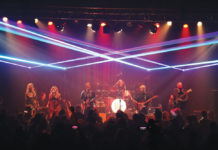Story and photos by Frank Robertson
Staff Writer
The Russian River’s anticipated Big Dry Up this summer hasn’t
happened yet, much to the relief of summertime fun vendors like
Larry Laba of Russian River Adventures in Healdsburg.
“So far so good,” said Laba who rents SOAR (Somewhere On A
River) inflatable kayaks to paddlers voyaging downriver below the
Healdsburg Memorial Beach summer dam.
“We’re hanging in there,” said Linda Burke, of Burke’s Canoe
Rentals in Forestville, where paddlers navigate the River to
Guerneville and take the Burke’s Canoes school bus back to their
cars. “We’ll see how it goes in the long run.”
At Guerneville’s Johnson’s Beach, “Business has been huge,”
owner Clare Harris said last Sunday as beachgoers lined up at the
concession stand to rent canoes, kayaks and peddle boats and scarf
hamburgers and beer.
Harris said the recession may be helping the River’s
recreation-dependent economy.
“It’s because people aren’t traveling,” said Harris. “They’re
staying home and coming here.”
A drastic cut in River flows that had been expected after the
Fourth of July weekend never materialized owing to factors such as
an aggressive water conservation effort by the Sonoma County Water
Agency and its 600,000 customers in Marin and Sonoma counties.
SCWA is under temporary state orders to cut its water deliveries
by 25 percent through Oct. 2. Without the cut Lake Mendocino was
projected to run dry in September when lake water behind Coyote Dam
is needed for release to aid the fall salmon migration.
County officials as well as beach vendors now have their
fingers crossed the remainder of the season will not require the
flow to be cut to a “critical dry year” level of 35 cfs below
Healdsburg.
“We don’t expect it to be lower than 80 or 85 cubic feet per
second,” said 5th District Supervisor Efren Carrillo two weeks ago
at a dedication ceremony for Sunset Beach, the county’s newest
River access park just west of the Hacienda Bridge.
The River flow at Hacienda was about 80 cfs last week, according
to the gauge on the Hacienda Bridge. That’s about half the minimum
flow of 125 cfs the Water Agency must maintain under its state
River diversion permits.
Last weekend it was hard to find much evidence that low-flow
has done any harm to this summer’s Russian River recreation
economy.
In Guerneville the installation of two summer dams means boaters
and bathers don’t see much difference anyway when they’re out on
the lakes that fill up behind dams at Vacation Beach and Johnson’s
Beach, arguably the most popular beach on the River.
Healdsburg’s Memorial Beach dam also backs water up about a mile
and a half for swimming and boating.
With school about to start (Windsor High School starts next
week, and Healdsburg, Analy and El Molino High Schools the
following week) some say that summer is basically over and it’s
been a pretty good year, maybe even great compared with the
economic hit the recreational community feared last April when the
state’s low-flow order came down.
The River was flowing at about 80 cubic feet per second (cfs) at
the Hacienda Bridge this weekend, below the historic normal year
minimum level of 125 cfs but still well above the “critical dry
year” 35 cfs that no one in recent history has really ever
experienced.
River flow at “critical dry” was projected to look like a
trickle and had veteran River watchers like Don McEnhill of the
Russian Riverkeeper environmental watchdog project predicting canoe
renters would be out of business.
Healdsburg’s venerable canoe man W.C. “Bob” Trowbridge used to
say the Russian River is the most canoed river in the world, and it
looked like it last Saturday.
Burke’s Canoes on River Road was overflowing with cars and
Guerneville was wall-to-wall with visitors on account of the
Vineman triathalon and Lazy Bear Weekend coincidentally merging
into one big carnival of swimming, running, biking and
growling.
At Sunset Beach where the River was the lowest it’s been all
summer, canoeists poked their paddles in the river bottom and
pushed off, in effect poling their boats past a narrow stretch of
river where a tree partly blocked passage.
All paddlers made it through without anyone having to get out to
push or pull a canoe — but what if they did? It’s not as though
getting your feet wet on a sunny day in August is the end of the
world. The River looked resplendent, a deep clear green mirror
reflecting sunlight bouncing off the ripples of a breeze.
People in canoes and kayaks paddled past in droves. Where’s the
hardship in this picture? I wondered. We could all use more
suffering like this.
Coming to terms with River germs
Beachgoers were told not to swim at three popular Russian River
beaches again last weekend owing to higher than normal bacteria
counts.
Johnson’s Beach, Camp Rose Beach and Cloverdale River Park Beach
were listed on Sunday for health warnings “Until further notice …
due to levels of bacteria that exceed state guidelines,” said a
county health advisory hotline.
The latest warnings pushed the total number of Russian River
beach bacteria advisories this summer to more than 40, the most
ever recorded since the sampling began in the 1990s.
Last year Sonoma County Environmental Health Division samplings
showed a total of 18 high River readings, compared with two in 2007
and one in 2006.
Some say lower Russian River flows are a contributing factor,
concentrating potential bacterial pollution that would be diluted
if more water was flowing.
“The trouble is that water isn’t moving fast enough to flush it
out,” said Monte Rio Recreation and Park District Director Steve
Baxman. Guerneville’s Johnson’s Beach and the Monte Rio beach have
seen the highest number of advisories with nine this summer, mostly
in designated shallow “kiddie beach” areas close to shore.
Although River flow levels have remained at or near normal for
much of the summer, more frequent incidents of higher bacteria
counts have been showing along the River’s entire reach in Sonoma
County, from Cloverdale to the estuary at Jenner.
The enterococcus bacteria count measured 148 organisms per 100
milliliters of river water sampled last Thursday at Healdsburg’s
Camp Rose Beach, according to the Sonoma County Department of
Health Services. The state advisory safe level is 61 per 100
ml.
The Health Department’s Environmental Health Division has a
beach sampling hotline this summer which the public can call to
find out whether any beaches have been posted with warnings. The
number is 565-6552.
Samples are tested for levels of total coliform, E. coli
(Eschericha coli), and enterococcus bacteria as indicators of water
quality. Though these are not considered disease-causing agents,
“their presence above certain numeric levels is suggestive of the
presence of other, difficult to detect and quantify pathogenic
microorganisms that can cause health effects,” says the Health
Department’s guidance information. “The use of these indicators is
an effective way of monitoring the overall well-being of
recreational waters.”
—F.R.
52.5
F
Healdsburg
March 16, 2025








